The history of the modern automobile began on Jan. 29, 1886 when
engineer Carl Benz registered a patent in the city of Mannheim for his
motorcar.
It was a vehicle with three wheels – called a "tricycle" on the
patent application – equipped with an internal-combustion engine. The
machine could generate 0.8 horsepower (0.6 kilowatts), was started with a
crank and had a top speed of 18 km/h (11.2 mph)
Another car, created separately not long afterwards by gun maker
Gottfried Daimler in Stuttgart, couldn't quite reach that kind of speed.
His vehicle only got up to 16 km/h (10 mph), but it did have four
wheels, resembling a modified horse-drawn cab. Daimler worked with
engine builder Wilhelm Maybach – a legendary partnership that still
exists today.
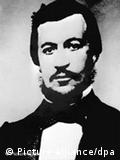 Nikolaus August Otto invented the first efficient internal-combustion engine
Nikolaus August Otto invented the first efficient internal-combustion engine
The Otto and Diesel motors
German design engineer Nikolaus August Otto patented his motor, which
now carries his name, in 1876. Rudolf Diesel registered his own version
of the internal-combustion engine, which stood out for its high
efficiency, in 1892.
In one of history's little ironies, the first speed records were
actually set with electric cars. In 1901, one vehicle exceeded 100 km/h
(62 mph).
The gasoline-powered engine was not yet the standard, and around the
turn of the century, different types of drives were still competing with
one another. Manufacturing data from American producers in 1900 shows
that 75 makers assembled a total of 4,192 automobiles during that year,
including 1,688 steam-driven vehicles and 1,575 electric cars. Only 929
of the cars made had gasoline engines.
It took about another two decades for gasoline engines to establish
themselves. But they eventually took the top spot thanks to their higher
speeds, better motors, cheap fuel, and the much greater distances they
could cover, especially compared to electric motors with their weak
batteries.
Ford's assembly line
Many pioneers were developing their own motor-driven cars in these
early days and the first car factories were built around 1890 in Europe
and the US. For years, cars were only within reach of the wealthy, but
Henry Ford soon changed that. His Ford Motor Company, based in Detroit,
Michigan, focused on vehicles that even the "normal man" could afford.
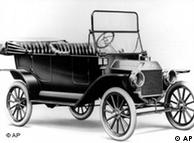 Ford's Model T, or "Tin Lizzy," changed the car industry
Ford's Model T, or "Tin Lizzy," changed the car industry
Ford's much-loved Model T had been on the market since 1908, but when
the carmaker switched over to assembly line production instead of
individual hand crafting, it marked the start of a new age for the
automobile.
Everyone who worked at Ford, the company's founder thought, should be
able to afford one of its cars. Wages in his plants were appreciably
higher than in other sectors and due to the economic success of his
model, he was able to shorten the working week.
According to his philosophy, his employees should have enough leisure
time to enjoy life and enough money to buy his cars. With this outlook,
incidentally, Ford set the foundation of our modern consumer society.
The Model T was produced using the same design until 1927. All in
all, 15 million "Tin Lizzies" rolled off the line, a production record
which held for the next 45 years.
Daimler and Benz
Back in Germany two firms, Daimler and Benz, merged forces in 1926,
although their founders played no role in the decision. Founder
Gottfried Daimler had died in 1900, and internal disputes had convinced
Carl Benz to leave the company he founded. In fact, Daimler and Benz
never actually met one another.
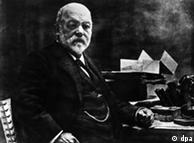 The last known photograph of Gottlieb Daimler
The last known photograph of Gottlieb Daimler
All the cars which were built by the new Daimler-Benz company were
called "Mercedes," a name for which the Daimler Motor Company took out
legal protection in 1901. The now-famous brand can be traced back to
Emil Jellinek, one of the company's important business partners whose
daughter was named Mercedes.
The distinctive Daimler-Benz symbol resulted from a combination of
the Mercedes star and the laurel wreath used by Benz. Today, this
brand's cars are expensive purchases, and even back then, only a fairly
exclusive clientele could afford them. That was the case with any of the
other 90 carmakers who were in business in Germany after World War I.
Porsche and VW
But Austrian design engineer Ferdinand Porsche wanted to change all
that. The talented tinkerer, who was employed by several car firms in
the early part of his career, had already built the world's first autos
featuring all-wheel and even hybrid drives. These were innovations that
were soon abandoned due to their high cost.
When Porsche decided to go out on his own, he had already been head of construction and a member of the board at Daimler.
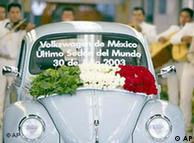 The last traditional VW Beetle rolls off the Mexican assembly line
The last traditional VW Beetle rolls off the Mexican assembly line
Shortly after he founded the Dr. Ing. h.c.F. Porsche GmbH company in
Stuttgart in 1930, plans for a car that would be within reach of the
masses got underway.
In 1934, Porsche signed a contract with the German government that
stipulated the construction of a "people's car," or Volkswagen. A
prototype was eventually built and its final form decided upon in 1937.
One year later, a new town was founded in northern Germany for the
car's production. It originally had the rather unwieldy name of "City of
the KdF-car at Fallersleben." (KdF, the German initials for "strength
through joy," was a Nazi leisure-time organization and a state tool to
promote the advantages of National Socialism to the German population.")
Today, the town is called Wolfsburg.
Workers who were to build the Volkswagen lived in the town, right
next to the new factory. In 1940, after the outbreak of World War II,
armament production began there.
Although the factory buildings were largely destroyed during the war,
car production got underway again just a few weeks after the war ended.
Four years later, Volkswagen car number 50,000 rolled off the assembly
line.
The 'Beetle'
The four-meter-long car with the memorable chassis and an air-cooled,
four-cylinder engine under the hood was soon christened the "Beetle" by
an enthusiastic public (later, the name became official). In the 50s,
it developed into a symbol of Germany's post-war "economic miracle." On
August 5, 1955, the millionth Beetle came off the assembly line to much
jubilation.
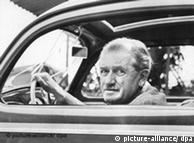 Ferdinand Porsche was the man behind the Beetle
Ferdinand Porsche was the man behind the Beetle
In 1972, the 15 million mark was reached and Beetle production
knocked Ford's Model T out of its first-place position. On July 30,
2003, the last Beetle was produced in Mexico, where production had been
moved more than 30 years previously. The last of the 21,529,464 Beetles
built is on display in Wolfsburg.
Globalization and concentration
Since its early days the auto industry has had a global outlook
regarding mass production. Germany has always seemed like a lucrative
market for American executives.
At the end of the 1920s, seven American auto concerns had a presence
in Germany. Henry Ford founded a German subsidiary back in 1925 in
Berlin. That factory was closed in 1931 and production moved to Cologne,
where it still is today.
Family-owned enterprise Opel was Germany's biggest auto manufacturer
at the end of the 1920s. Under pressure from the growing global economic
crisis of the time, the descendents of Adam Opel turned the firm into a
publicly held company.
General Motors acquired a majority stake in Opel, and in 1931 it
fully took over the concern. However, a German management team was put
in place, the name Opel kept, and its own model line continued.
The big five
While they don't exactly fit the criteria, Ford-Germany and GM
subsidiary Opel are among the few remaining German car manufacturers.
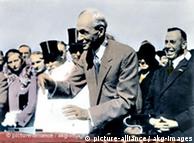 Henry Ford lays the cornerstone for his new factory in Cologne
Henry Ford lays the cornerstone for his new factory in Cologne
Of the several dozen carmakers in business after both World Wars,
only three have survived as independent companies: Volkswagen with its
subsidiaries Audi and, recently, Porsche; Daimler with its renowned
Mercedes brand; and BMW.
On the list of the globe's biggest car manufacturers, VW comes in
third place behind Toyota and General Motors. Daimler and BMW make it
into the top 15 according to sales.
"The global demand for automobiles will not surpass one million – if
for nothing else due to a lack of chauffeurs," was a prediction ascribed
to car pioneer Gottfried Daimler. Despite his accomplishments, on this
question he couldn't have been more mistaken.
In 2010, around 60 million new cars were sold worldwide. In 2011,
around 67 million in sales are expected. The total number of cars around
the world is estimated at someone around one billion.
Author: Klaus Ulrich (jam)
Editor: Kristin Zeier









